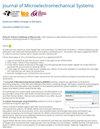Microfluidic Biosensor for the In Vitro Electrophysiological Characterization of Actin Bundles
IF 2.5
3区 工程技术
Q2 ENGINEERING, ELECTRICAL & ELECTRONIC
引用次数: 0
Abstract
The essential cytoskeletal protein actin and its functions are paramount for motility, communication, and locomotive processes in eukaryotic cells. Detection and quantification of actin protein is of great interest for in vitro studies potentially elucidating unknown cellular mechanisms affecting drug responses with an extension to the study of disease states (e.g., study of neurodegenerative disorders). To this end, development of biomedical platforms and biosensors plays an important role in providing reliable and sensitive devices to study such intracellular constructs. Here, we present for the first time the microfabrication, characterization, testing, and electrical/interfacial modeling of a microfluidic biosensor for actin protein characterization. The device allows for the interaction and characterization of actin bundles using electrochemical impedance spectroscopy (EIS). The device was tested with用于体外肌动蛋白束电生理学表征的微流控生物传感器
细胞骨架蛋白肌动蛋白及其功能对真核细胞的运动、交流和动力过程至关重要。肌动蛋白的检测和定量对于体外研究具有重大意义,有可能阐明影响药物反应的未知细胞机制,并扩展到疾病状态研究(如神经退行性疾病研究)。为此,生物医学平台和生物传感器的开发在提供可靠、灵敏的设备以研究此类细胞内结构方面发挥着重要作用。在这里,我们首次展示了用于肌动蛋白表征的微流控生物传感器的微加工、表征、测试和电学/界面建模。该装置可利用电化学阻抗光谱(EIS)对肌动蛋白束进行相互作用和表征。该装置用 1 \mu \text{M}$ 和 8 \mu \text{M}$ 的肌动蛋白束浓度进行了测试,在 1 kHz 的重要生物频率下产生了从 17 到 30 kOhm ($\text{k}\Omega $)的阻抗响应变化。对 1 \mu \text{M}$ 浓度和两个介电常数($\boldsymbol {\varepsilon }_{\mathbf {r}}$ = 5 和 78)下的界面电容进行了评估,结果分别为 3.8 和 15.6 mF/m2。同样,对于 8 \mu \text{M}$浓度,在相同的 $\boldsymbol {\varepsilon }_{\mathbf {r}}$ 值下,界面电容分别为 10.1 和 43.3 mF/m2 。基于这些理论计算,界面模型可以准确预测之前通过实验 EIS 方法阐明的肌动蛋白束的量化。[2023-0180]
本文章由计算机程序翻译,如有差异,请以英文原文为准。
求助全文
约1分钟内获得全文
求助全文
来源期刊

Journal of Microelectromechanical Systems
工程技术-工程:电子与电气
CiteScore
6.20
自引率
7.40%
发文量
115
审稿时长
7.5 months
期刊介绍:
The topics of interest include, but are not limited to: devices ranging in size from microns to millimeters, IC-compatible fabrication techniques, other fabrication techniques, measurement of micro phenomena, theoretical results, new materials and designs, micro actuators, micro robots, micro batteries, bearings, wear, reliability, electrical interconnections, micro telemanipulation, and standards appropriate to MEMS. Application examples and application oriented devices in fluidics, optics, bio-medical engineering, etc., are also of central interest.
 求助内容:
求助内容: 应助结果提醒方式:
应助结果提醒方式:


